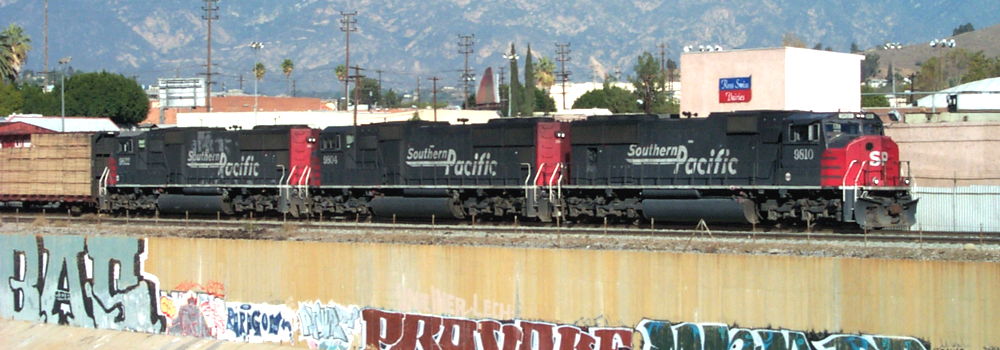Railroad Frequencies (Non AAR Channel Band)

There are frequencies that railroads utilize outside of the typical AAR 160-161 MHz channel band plan. Here's a list of some of them...
Train Telemetry (EoTD, DPU, RLC)
These frequencies are utilized for End/Head of Train Devices, Distributed Power Unit loco control, and Remote Control of Locomotives.
| 452.92500 - Mobile - DPU Channel 1 - Distributed Power |
| 452.93125 - Mobile - RLC - Remote Locomotive Control |
| 452.93750 - Mobile - HoTD - Head of Train Device transmitters |
| 452.94375 - Mobile - RLC - Remote Locomotive Control |
| 452.95000 - Mobile - DPU Channel 2 - Distributed Power |
| 452.95625 - Mobile - RLC - Remote Locomotive Control |
| 452.96250 - Mobile - RLC - Remote Locomotive Control |
| 452.96875 - Mobile - RLC - Remote Locomotive Control |
| 457.92500 - Mobile - DPU Channel 3 - Distributed Power |
| 457.93750 - Mobile - EoTD - End of Train Device transmitters |
| 457.95000 - Mobile - DPU Channel 4 - Distributed Power |
VHF Marine Channel 16
156.800 This can sometimes be the calling frequency for lift bridges. Marine Channels 13 (156.650) and 14 (156.7) have also been reported as occasionally used in this way, in some areas.
Advanced Train Control Systems (ATCS)
This is a system that larger railroads are using on upper 800 and 900 MHz frequencies. The frequencies are being registered under the Association of American Railroads, or the Transportation Technology Center, not the individual railroads that use them. These radio systems basically collect information about train movement and other things along the line. This information is sent to computers and is then used to create the real time displays dispatchers have on their screens, showing train movement and so on. The data isn't always sent through the air, but when it is, it's done in a duplex method using two different frequencies. Small high band yagi antennas at various points along the right-of-way are usually used for these transmissions.
| Channel - 1 Mobile - 896.8875 MHz / Base - MHz 935.8875 Union Pacific |
| Channel - 2 Mobile - 896.9375 MHz / Base - MHz 935.9375 CSX |
| Channel - 3 Mobile - 896.9875 MHz / Base - MHz 935.9875 Shared Network |
| Channel - 4 Mobile - 897.8875 MHz / Base - MHz 936.8875 BNSF |
| Channel - 5 Mobile - 897.9375 MHz / Base - MHz 936.9375 Norfolk Southern |
| Channel - 6 Mobile - 897.9875 MHz / Base - 936.9875 MHz ??? |
| Allocated - Base/Mobile - 928.00625 MHz |
| Allocated - Base/Mobile - 928.01875 MHz |
| Allocated - Base/Mobile - 928.03125 MHz |
| Allocated - Base/Mobile - 928.04375 MHz |
| Allocated - Base/Mobile - 928.05625 MHz |
| Allocated - Base/Mobile - 928.06875 MHz |
| Allocated - Base/Mobile - 928.08125 MHz |
Positive Train Control
Positive Train Control (PTC) is a fairly recent new safety system that helps lower the chance of train collisions. The following frequencies are set aside for this system nationwide in the US.
| Channel - 1 Base - 220.1275 MHz / Mobile - 221.1275 MHz |
| Channel - 2 Base - 220.1325 MHz / Mobile - 221.1325 MHz |
| Channel - 3 Base - 220.1375 MHz / Mobile - 221.1375 MHz |
| Channel - 4 Base - 220.1425 MHz / Mobile - 221.1425 MHz |
| Channel - 5 Base - 220.1475 MHz / Mobile - 221.1475 MHz |
| Channel - 6 Base - 220.7525 MHz / Mobile - 221.7525 MHz |
| Channel - 7 Base - 220.7675 MHz / Mobile - 221.7625 MHz |
| Channel - 8 Base - 220.7725 MHz / Mobile - 221.7725 MHz |
| Channel - 9 Base - 220.7575 MHz / Mobile - 221.7575 MHz |
| Channel - 10 Base - 220.1025 MHz / Mobile - 221.1025 MHz |
| Channel - 11 Base - 220.1075 MHz / Mobile - 221.1075 MHz |
| Channel - 12 Base - 220.1125 MHz / Mobile - 221.1125 MHz |
| Channel - 13 Base - 220.1175 MHz / Mobile - 221.1175 MHz |
| Channel - 14 Base - 220.1225 MHz / Mobile - 221.1225 MHz |
| Channel - 15 Base - 220.7775 MHz / Mobile - 221.7775 MHz |
| Channel - 16 Base - 220.7825 MHz / Mobile - 221.7825 MHz |
| Channel - 17 Base - 220.7875 MHz / Mobile - 221.7875 MHz |
| Channel - 18 Base - 220.7925 MHz / Mobile - 221.7925 MHz |
| Channel - 19 Base - 220.7975 MHz / Mobile - 221.7975 MHz |
Various Frequencies
The below frequencies are listed as being set aside for rail use in the national FCC database. It's unknown how many of them are being used now, and for what purpose. Some of the 900 MHz frequencies are being used for the above mentioned ATCS.
|
72.520 MHz
|
936.9875 MHz
|
|
162.4000 MHz
|
936.9880 MHz
|
|
935.8875 MHz
|
1875.000 MHz
|
|
935.8880 MHz
|
1895.000 MHz
|
|
935.9375 MHz
|
1955.000 MHz
|
|
935.9380 MHz
|
1965.000 MHz
|
|
935.9875 MHz
|
1975.000 MHz
|
|
935.9880 MHz
|
1985.000 MHz
|
|
936.8875 MHz
|
6665.000 MHz
|
|
936.8880 MHz
|
6705.000 MHz
|
|
936.9375 MHz
|
6825.000 MHz
|
|
936.9380 MHz
|
6865.000 MHz
|
|
902.000 - 928.000 MHz (AEI Car Tag Systems)
|
|
| 44.58 MHz - (BNSF HyRail Limits System) | |
Ham Radio
It's been reported that hams have sometimes talked with crew members operating trains, who are also hams. Frequencies to monitor for this are 2 meter simplex...
| 146.460 MHz | 146.940 MHz |
| 146.490 MHz | 147.300 MHz |
